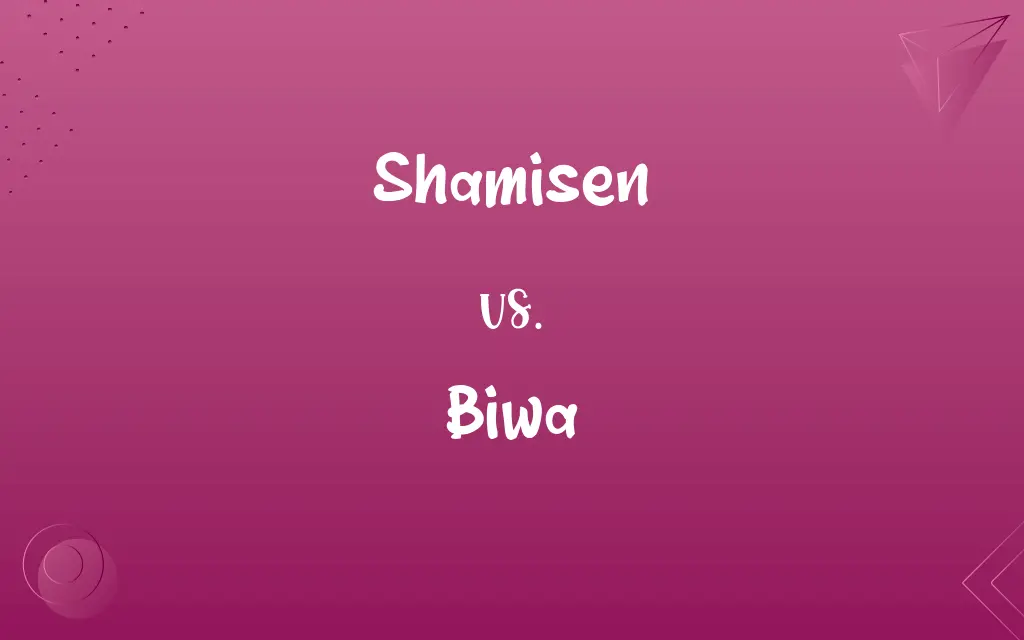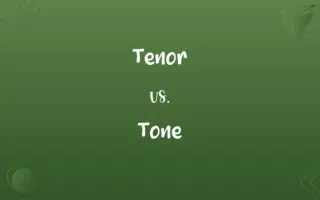Shamisen vs. Biwa: Know the Difference

By Hifza Nasir & Shumaila Saeed || Published on June 21, 2024
The shamisen is a three-stringed Japanese instrument played with a plectrum, known for its sharp, percussive sound, while the biwa is a pear-shaped, lute-like instrument with four to five strings, producing a deeper, more resonant tone.

Key Differences
The shamisen, a traditional Japanese instrument, features three strings stretched over a long, fretless neck and a square or rectangular body covered with skin, similar to that of a banjo. Players use a large plectrum called a bachi to strike the strings, creating a distinctive, twangy sound that is both percussive and melodic. On the other hand, the biwa is characterized by its pear-shaped body, short neck, and four to five strings, played with a plectrum, producing a deep, rich sound. The biwa's body is also covered with skin, and it has frets, which allow for more varied tonal expressions.
Hifza Nasir
Jun 21, 2024
While the shamisen is often associated with various forms of Japanese traditional music and theater, such as kabuki and bunraku, its versatility has also led to its use in contemporary music genres. The instrument is celebrated for its expressive range, capable of conveying a wide array of emotions. Conversely, the biwa has a strong association with narrative storytelling, particularly the epic tales of the Heike Monogatari, where it accompanies vocal performances. The biwa is revered for its evocative sound, capable of creating an immersive storytelling atmosphere.
Shumaila Saeed
Jun 21, 2024
The shamisen's body, made from different types of wood or sometimes other materials, is distinctively covered on both sides by cat or dog skin, contributing to its unique sound quality. The skin's tension can be adjusted to change the instrument's tone. Whereas the biwa's body is traditionally made from mulberry or other hardwoods and covered with cat or dog skin on the front side only, this construction gives the biwa a sonorous quality that is deeply resonant and melodic.
Hifza Nasir
Jun 21, 2024
Regarding playing technique, shamisen players often utilize a variety of striking methods, including rapid strumming and percussive tapping on the body, to create a diverse range of sounds. In contrast, biwa players use a combination of plucking and strumming, with the plectrum often striking against the strings and body for rhythmic emphasis. The biwa's frets enable precise melodic control, allowing for intricate musical expressions.
Hifza Nasir
Jun 21, 2024
Despite their differences, both instruments hold significant cultural importance in Japan, symbolizing the country's rich musical heritage. The shamisen and the biwa each offer unique auditory experiences, reflecting the complexity and depth of Japanese traditional music and storytelling.
Dua Fatima
Jun 21, 2024
ADVERTISEMENT
Comparison Chart
Shape
Long, fretless neck with a square or rectangular body.
Pear-shaped body with a short neck.
Hifza Nasir
Jun 21, 2024
Sound Production
Played with a large plectrum (bachi), producing a sharp, percussive sound.
Played with a plectrum, producing a deep, resonant tone.
Hifza Nasir
Jun 21, 2024
Material
Body often covered with cat or dog skin; made of wood or other materials.
Body made from mulberry or other hardwoods, covered with skin on the front.
Shumaila Saeed
Jun 21, 2024
Use
Associated with kabuki, bunraku, and contemporary music.
Strongly associated with narrative storytelling and epic tales.
Hifza Nasir
Jun 21, 2024
ADVERTISEMENT
Shamisen and Biwa Definitions
Shamisen
Used in traditional and contemporary Japanese music.
The fusion band incorporated the shamisen to add a traditional touch to their sound.
Hifza Nasir
Mar 05, 2024
Biwa
Often associated with storytelling and epic narratives.
She accompanied the ancient tale with her expressive biwa playing.
Hifza Nasir
Mar 05, 2024
Shamisen
A three-stringed Japanese instrument with a distinctive.twangy sound.
The shamisen player captivated the audience with her skillful performance.
Hifza Nasir
Mar 05, 2024
Biwa
Has a body covered with skin on the front side.
The carefully crafted biwa resonated beautifully in the intimate setting.
Hifza Nasir
Mar 05, 2024
Shamisen
Features a square or rectangular body covered with skin.
The shamisen's resonant body amplified its unique sound.
Shumaila Saeed
Mar 05, 2024
ADVERTISEMENT
Biwa
Played with a plectrum.featuring four to five strings.
The biwa player's deft fingers moved smoothly over the strings.
Hifza Nasir
Mar 05, 2024
Shamisen
Emphasizes percussive and melodic techniques.
The musician's rapid shamisen strumming filled the room with rhythm.
Dua Fatima
Mar 05, 2024
Biwa
A pear-shaped.lute-like Japanese instrument with a deep.melodic tone.
The biwa's rich sound added depth to the traditional performance.
Hifza Nasir
Mar 05, 2024
Shamisen
Played with a large plectrum called a bachi.
He held the bachi firmly as he struck the shamisen's strings.
Hifza Nasir
Mar 05, 2024
Biwa
Utilizes plucking and strumming, with precise melodic control.
The intricate melodies he played on the biwa were mesmerizing.
Shumaila Saeed
Mar 05, 2024
Shamisen
A Japanese musical instrument resembling a lute, having a very long neck and three strings played with a plectrum.
Hifza Nasir
Mar 05, 2024
Biwa
A plucked lute, originating in the classical and traditional music of Japan, characterized by a pear-shaped body and four or five high frets, giving the instrument a distinctively twangy tone.
Hifza Nasir
Mar 05, 2024
Shamisen
(musical instrument) A kind of three-stringed Japanese fretless lute.
Hifza Nasir
Mar 05, 2024
Shamisen
A Japanese stringed instrument resembling a banjo with a long neck and three strings and a fretted fingerboard and a rectangular soundbox; played with a plectrum
Hifza Nasir
Mar 05, 2024
Repeatedly Asked Queries
What are the physical characteristics of a shamisen?
The shamisen has a long, fretless neck, a square or rectangular body covered with skin, and three strings.
Dua Fatima
Jun 21, 2024
What distinguishes the sound of a biwa?
The biwa produces a deep, resonant tone, ideal for accompanying narratives and creating atmospheric music.
Hifza Nasir
Jun 21, 2024
How is the shamisen played?
The shamisen is played with a large plectrum called a bachi, using techniques that include striking, strumming, and tapping.
Hifza Nasir
Jun 21, 2024
What materials are used to make these instruments?
Shamisen bodies are often made of wood and covered with cat or dog skin, while biwas are typically made from hardwoods like mulberry and similarly covered with skin.
Hifza Nasir
Jun 21, 2024
How important are these instruments in Japanese culture?
Both instruments are highly regarded in Japanese culture, representing centuries of musical tradition and storytelling.
Hifza Nasir
Jun 21, 2024
What kind of music is the shamisen used for?
The shamisen is used in traditional Japanese music, theater (such as kabuki and bunraku), and contemporary genres.
Hifza Nasir
Jun 21, 2024
Can the biwa be used in modern music?
While traditionally used for storytelling and classical music, the biwa can also be incorporated into modern music compositions.
Dua Fatima
Jun 21, 2024
Are shamisen and biwa easy to learn for beginners?
Both instruments require dedicated practice to master, with the shamisen's percussive style and the biwa's melodic control posing unique challenges.
Shumaila Saeed
Jun 21, 2024
Can the shamisen and biwa be played solo or in ensembles?
Both instruments are versatile and can be played solo or as part of an ensemble, depending on the musical context.
Dua Fatima
Jun 21, 2024
How does the biwa's design contribute to its sound?
The biwa's pear-shaped body and skin-covered front, along with its frets, contribute to its rich, melodic sound.
Dua Fatima
Jun 21, 2024
What is the historical significance of the biwa?
The biwa has a long history in Japan, closely associated with the narration of epic tales and court music.
Hifza Nasir
Jun 21, 2024
Share this page
Link for your blog / website
HTML
Link to share via messenger
About Author
Written by
Hifza NasirCo-written by
Shumaila SaeedShumaila Saeed, an expert content creator with 6 years of experience, specializes in distilling complex topics into easily digestible comparisons, shining a light on the nuances that both inform and educate readers with clarity and accuracy.






































































